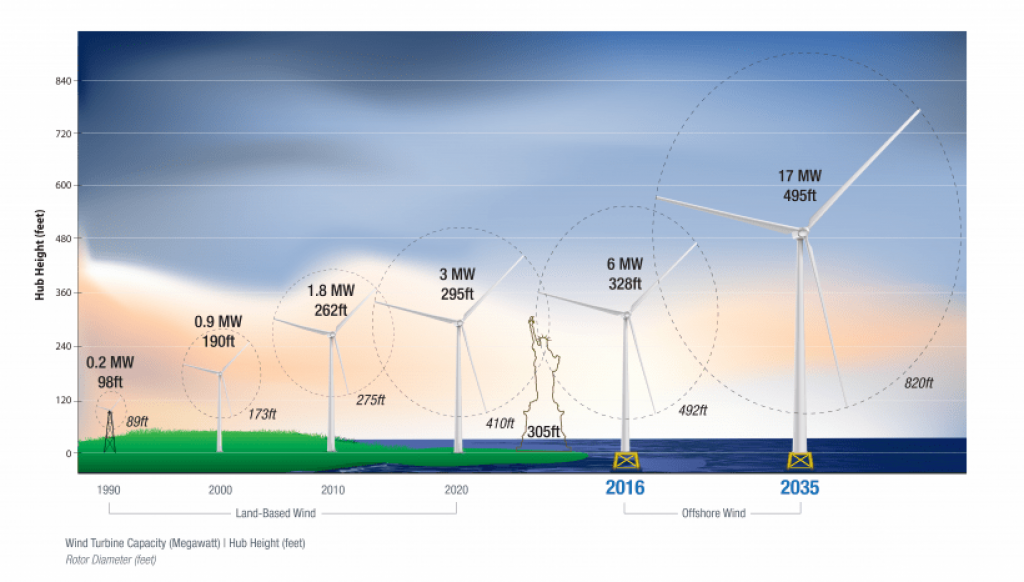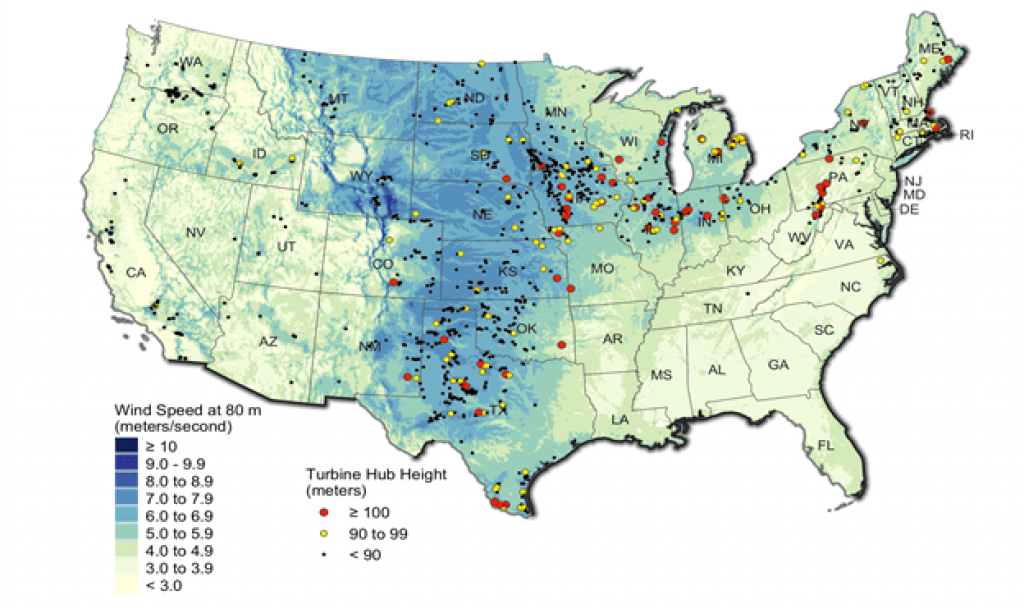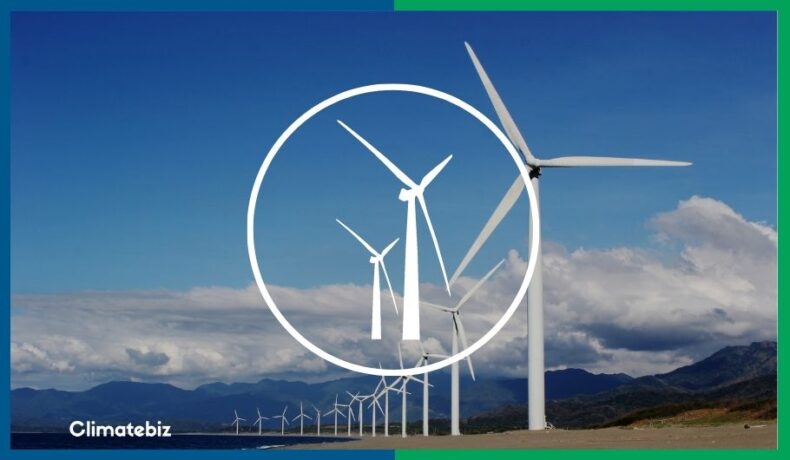Wind turbines are found onshore and offshore. They tower above the landscape to harness the kinetic energy of the wind. But what is the average wind turbine height, and how does it affect energy production?
Here’s some background information before we explore this question further.
According to the Global Wind Council, the world produced 743 gigawatts of electricity in 2021 through wind turbines. To put that into perspective, that amount of energy can power the entire state of Texas for a week.
Sure, that might not sound like much, but new wind turbines are erected each year. With the Paris agreement slowly edging closer, more countries are turning to wind power to subsidize their fossil fuel usage.
Wind turbines are placed on towers to harness the faster wind speeds at that height. However, the golden zone for high wind speeds is different in each country. This means that wind turbines will have varying heights depending on their location.
Table of Contents
What Is The Average Wind Turbine Height?
Wind turbines can be as tall as 32 feet to 500 feet. Currently, the tallest wind turbine globally has an overall height (including blade length) of 800 feet. The turbine was built by Max Bögl Wind AG and is located in Germany.
But why are wind turbines so tall? The wind’s kinetic energy influences the height of a wind turbine. For example, the wind speed increased by 20% for every 32 feet up. This difference can increase a wind turbine’s efficiency by 34%.
Wind Turbine Heights From Across The World
An interesting concept is how different countries have different average wind turbine heights. For example, the average height of wind turbines in America is double that of Spain.
The height of a wind turbine is determined by wind speed and efficiency. Therefore, the turbines need to be taller in geographical locations with mountains. On the other hand, flatter regions can have shorter turbines because there are no disruptions in the wind.
The same can be said for turbines near cities. The wind flows around the buildings, causing unpredictable wind patterns. The urban environment also makes the wind volatile, creating more wind shear.
Wind shear is currents of wind that flow 90 degrees to the wind direction — it can either help or decrease the efficiency of a wind turbine. But since it’s unpredictable, it’s best to avoid it.
This is why you typically find wind turbines on open plains or offshore.
Examples Of Wind Turbine Heights
| Country | Average Height (Ft) | GW Generated |
|---|---|---|
| 1st – China | 33 | 288 |
| 2nd – U.S.A | 262 | 122 |
| 3rd – Germany | 492 | 63 |
| 4th – India | 279 | 39 |
| 5th – Spain | 130 | 27 |
From this table, you can see that the average height of wind turbines is 243 feet. What’s also noticeable is that the wind turbine’s height depends on its geographical location.
For example, China’s average wind turbine is 33 feet tall, yet they generate the most wind energy globally.
What Is The Maximum Wind Turbine Height?

Source: energy.gov
According to Vox, the average maximum height in the U.S.A is 500 feet. The Office of Energy Efficiency & Renewable Energy confirms this height. However, 500 feet is the max for offshore turbines, while onshore has a maximum of 295 feet.
There are two different figures for the technical heights of turbines. The most common figure includes the diameter of the blades – the overall total height. On the other hand, you can measure a turbine’s hub height.
The wind turbine hub is where all the mechanical parts, generator, and electrical wiring are housed. In this article, we’ll be referring to the hub height unless otherwise stated.
Why Are Turbines Restricted To A Maximum Height?
There are two primary reasons why a wind turbine has a maximum height. The first one is more obvious – the taller the turbine, the more structurally complex it becomes. The second reason is airspace restrictions.
Did you know that the maximum wind turbine height is as tall as the statue of liberty? And that doesn’t include its massive blades. When you pass this level, there are many hoops you’ll have to start navigating.
The Federal Aviation Administration has additional requirements and steps that developers must follow. These make the process a painstaking one that most developers avoid.
However, the game changes when wind turbines are set up offshore.
Offshore wind turbines can be as tall as 500 feet. These massive machines have rotor blades that are 41 ft long and generate 17 MW of power.
Average Wind Turbine Heights
| Turbine Height (Ft) | Blade Length (Ft) | Location | Kilowatts |
|---|---|---|---|
| 82 | 24 | Onshore | 50 |
| 131 | 55 | Onshore | 300 |
| 197 | 79 | Onshore | 750 |
| 230 | 98 | Onshore | 1000 |
| 262 | 118 | Offshore | 2000 |
| 328 | 184 | Offshore | 5000 |
How Does Wind Turbine Height Influence Efficiency?

Source: Energy.gov
There are two ways in which the turbine’s height increases the amount of power generated. These are:
- Increased wind speed
- Larger rotor blades
We’ve already touched on how taller turbines catch the faster wind, but why is that so? In addition, what does turbine height have to do with the blade size?
Let’s find out.
Understanding Wind
Wind is the flow of air from high-pressure zones to low-pressure zones. The movement is caused by the earth’s unequal heating and rotation.
In general, the air moves up and away from the equator toward the poles. There, it cools down, creating a high-pressure zone. The cooler and lower air then flows back towards the equator, where the process repeats.
Friction is created as the air flows across the surface of the earth. This creates drag – slowing the wind. Wind drag is when the moving air interacts with the ground and vegetation, losing its kinetic energy. As this happens, the wind slows down. That’s why open plains experience faster winds than forests.
However, the wind above this zone flows freely, like an ice skater. Because no friction is holding it back, these winds can reach higher speeds.
Higher speeds – or higher movements increase kinetic energy availability.
Turbine Rotor Blades
The larger the turbine’s rotor blades are, the more wind they can catch. For example, a 20-foot blade can generate 17kW of power. So essentially, one square foot of rotor blade generates 600 watts of power in 20 mph winds.
The larger the sweep area of the turbine blades, the more electricity is generated. Therefore, the turbine hub needs to be placed higher up to allow larger blades.
The blade of a wind turbine is roughly 42% of the tower height of the turbine. The longer the turbine blade, the tall tower you’ll need.
Let’s look at a wind turbine with a 55-foot blade. The turbine hub needs to be placed 131 feet off the ground. We can also calculate that this turbine should be able to produce 5.7 megawatts of power in 20 mph winds.
Wind Turbine Height And Power Output Chart
Now that we’ve gone through all the theories of turbine height, let’s look at some actual figures.
The figures below are based on this study.
| Turbine Height (Ft) | Kilowatts |
|---|---|
| 82 | 50 |
| 131 | 300 |
| 197 | 750 |
| 230 | 1000 |
| 262 | 2000 |
| 328 | 5000 |
We’ve also made a line chart to present the power output curve graphically:
The chart clearly shows a significant power increase between the lowest and highest turbine. These figures were taken from a wind farm on the coast of Denmark.
Final Thoughts
The relationship between tower height and the power output of a turbine determines its efficiency. While there are other factors like wind speed and turbine blade diameter, it’s clear that the height will always affect the output.
Studies show that for every 32 feet increase in height, the turbine efficiency increases by 34%.
As green technology advances, both the output capacity and turbine heights increase. This makes wind power more efficient and an excellent future investment.
The size of wind turbines has increased by 59% since 1990, and their output by 85%.
It’s also interesting to note the different wind turbine heights worldwide. While China produces the most wind power — 288 GW – its towers are only 33 feet tall. The U.S.A produces 122 GW, yet its turbines are 262 feet tall. This reinforces that geographical location affects the efficiency of a wind turbine and its height.
We hope that this article has answered any questions you might have had on wind turbine heights. If you have any more questions, please join our online community.

